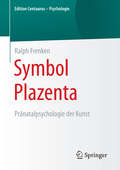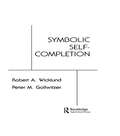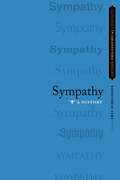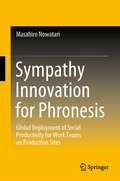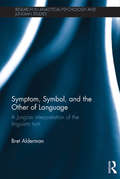- Table View
- List View
Symbol Formation
by H. Werner B. KaplanFirst published in 1984. Routledge is an imprint of Taylor & Francis, an informa company.
Symbol Formation
by H. Werner B. KaplanFirst published in 1984. Routledge is an imprint of Taylor & Francis, an informa company.
Symbol Plazenta: Pränatalpsychologie der Kunst (Edition Centaurus – Psychologie)
by Ralph FrenkenDas Buch stellt eine Auseinandersetzung mit den frühesten Objekterfahrungen des menschlichen Fötus dar. Die Pränatalpsychologie zeigt die Auswirkungen früher Erlebnisse auf Psychotherapien, auf Kunstwerke und die Religion. Ausgangspunkt ist: Der Fötus erlebt als erstes Objekt seine Plazenta. Er ist mit ihr über die Nabelschnur verbunden, er berührt sie und bildet zu ihr die erste Beziehung seines Lebens aus. Nach der Geburt zeigen sich Widerspiegelungen dieser ersten Beziehung im Umgang mit Übergangsobjekten, in Kinderzeichnungen und in der Phantasiewelt des Kindes. Vom Baum des Lebens im Paradies bis zum Roten Drachen der Apokalypse zeigen sich in der Kunst und in der Religion die Auswirkungen früher Erfahrungen – und werden durch das vorliegende Werk verstehbar.
Symbolic Action Theory and Cultural Psychology (Recent Research in Psychology)
by Ernest E. BoeschGustav Jahoda University of Strathclyde Ever since psychology emerged as a separate discipline about a century ago, there have been differing views as to what it is or ought to be. Some, like Ebbinghaus, saw it as a budding natural science, experimental and quantitative. Others, like Dilthey, regarded psychology in the main as a humane field of study, historical and interpretative in character. The dichotomy of "explaining" versus "understanding" has been a subject of debate ever since. Regrettably, most of the protagonists of these respec tive positions tend to view them as mutually exclusive, in spite of the fact that already Wundt had stressed that "hard" experimental and "soft" VOlkerpsychologie are both equally important. For the major part of the present century the field has been largely dominated by advocates of "hard-nosed" scientific approaches, typified first by Behaviorism and, latterly, cognitive psychology which concen trates on central processes involved in cognition. Without in any way wishing to denigrate the undoubted achievements of cognitive psycholo gy, it has its limitations that are epitomized by T. H. Huxley's dictum "The great end of life is not knowledge but action". This might well serve as the motto for the action theory of Ernest Boesch, who is one of several prominent psychologists out of harmony with the prevailing ethos. They travel under different banners such as "social constructivism", "ethogen ics" or "hermeneutics", but all share reservations about what many feel is the arid "scientism" of the mainstream.
A Symbolic and Connectionist Approach To Legal Information Retrieval
by Daniel E. RoseMany existing information retrieval (IR) systems are surprisingly ineffective at finding documents relevant to particular topics. Traditional systems are extremely brittle, failing to retrieve relevant documents unless the user's exact search string is found. They support only the most primitive trial-and-error interaction with their users and are also static. Even systems with so-called "relevance feedback" are incapable of learning from experience with users. SCALIR (a Symbolic and Connectionist Approach to Legal Information Retrieval) -- a system for assisting research on copyright law -- has been designed to address these problems. By using a hybrid of symbolic and connectionist artificial intelligence techniques, SCALIR develops a conceptual representation of document relationships without explicit knowledge engineering. SCALIR's direct manipulation interface encourages users to browse through the space of documents. It then uses these browsing patterns to improve its performance by modifying its representation, resulting in a communal repository of expertise for all of its users. SCALIR's representational scheme also mirrors the hybrid nature of the Anglo-American legal system. While certain legal concepts are precise and rule-like, others -- which legal scholars call "open-textured" -- are subject to interpretation. The meaning of legal text is established through the parallel and distributed precedence-based judicial appeal system. SCALIR represents documents and terms as nodes in a network, capturing the duality of the legal system by using symbolic (semantic network) and connectionist links. The former correspond to a priori knowledge such as the fact that one case overturned another on appeal. The latter correspond to statistical inferences such as the relevance of a term describing a case. SCALIR's text corpus includes all federal cases on copyright law. The hybrid representation also suggests a way to resolve the apparent incompatibility between the two prominent paradigms in artificial intelligence, the "classical" symbol-manipulation approach and the neurally-inspired connectionist approach. Part of the book focuses on a characterization of the two paradigms and an investigation of when and how -- as in the legal research domain -- they can be effectively combined.
A Symbolic and Connectionist Approach To Legal Information Retrieval
by Daniel E. RoseMany existing information retrieval (IR) systems are surprisingly ineffective at finding documents relevant to particular topics. Traditional systems are extremely brittle, failing to retrieve relevant documents unless the user's exact search string is found. They support only the most primitive trial-and-error interaction with their users and are also static. Even systems with so-called "relevance feedback" are incapable of learning from experience with users. SCALIR (a Symbolic and Connectionist Approach to Legal Information Retrieval) -- a system for assisting research on copyright law -- has been designed to address these problems. By using a hybrid of symbolic and connectionist artificial intelligence techniques, SCALIR develops a conceptual representation of document relationships without explicit knowledge engineering. SCALIR's direct manipulation interface encourages users to browse through the space of documents. It then uses these browsing patterns to improve its performance by modifying its representation, resulting in a communal repository of expertise for all of its users. SCALIR's representational scheme also mirrors the hybrid nature of the Anglo-American legal system. While certain legal concepts are precise and rule-like, others -- which legal scholars call "open-textured" -- are subject to interpretation. The meaning of legal text is established through the parallel and distributed precedence-based judicial appeal system. SCALIR represents documents and terms as nodes in a network, capturing the duality of the legal system by using symbolic (semantic network) and connectionist links. The former correspond to a priori knowledge such as the fact that one case overturned another on appeal. The latter correspond to statistical inferences such as the relevance of a term describing a case. SCALIR's text corpus includes all federal cases on copyright law. The hybrid representation also suggests a way to resolve the apparent incompatibility between the two prominent paradigms in artificial intelligence, the "classical" symbol-manipulation approach and the neurally-inspired connectionist approach. Part of the book focuses on a characterization of the two paradigms and an investigation of when and how -- as in the legal research domain -- they can be effectively combined.
The Symbolic and Connectionist Paradigms: Closing the Gap
by John DinsmoreThe modern study of cognition finds itself with two widely endorsed but seemingly incongruous theoretical paradigms. The first of these, inspired by formal logic and the digital computer, sees reasoning in the principled manipulation of structured symbolic representations. The second, inspired by the physiology of the brain, sees reasoning as the behavior that emerges from the direct interactions found in large networks of simple processing components. Each paradigm has its own accomplishments, problems, methodology, proponents, and agenda. This book records the thoughts of researchers -- from both computer science and philosophy -- on resolving the debate between the symbolic and connectionist paradigms. It addresses theoretical and methodological issues throughout, but at the same time exhibits the current attempts of practicing cognitive scientists to solve real problems.
The Symbolic and Connectionist Paradigms: Closing the Gap
by John DinsmoreThe modern study of cognition finds itself with two widely endorsed but seemingly incongruous theoretical paradigms. The first of these, inspired by formal logic and the digital computer, sees reasoning in the principled manipulation of structured symbolic representations. The second, inspired by the physiology of the brain, sees reasoning as the behavior that emerges from the direct interactions found in large networks of simple processing components. Each paradigm has its own accomplishments, problems, methodology, proponents, and agenda. This book records the thoughts of researchers -- from both computer science and philosophy -- on resolving the debate between the symbolic and connectionist paradigms. It addresses theoretical and methodological issues throughout, but at the same time exhibits the current attempts of practicing cognitive scientists to solve real problems.
A Symbolic Approach to Humanitarian Action: It Takes One to Know One (Contemporary Humanitarian Action and Emergency Management)
by Diego OteguiThis book aims to present an alternative view of humanitarian action. It adds to current conversations and dilemmas within the humanitarian sphere by departing from traditional views that consider humanitarian interventions as a concrete human activity aimed at providing relief to disaster victims. Much differently, it invokes the idea that humanitarian action is also a cognitive process. In this process, both humanitarians and disaster survivors alike, unknowingly, apply historically, societally, and culturally defined symbolic constructions to make sense of post-disaster information and to make decisions. In the specific case of humanitarian workers, these symbolic constructions influence how they understand their post-disaster reality, including how they relate to those they consider to be in pain or distress. This way of looking at humanitarian action builds upon a robust theoretical framework called Institutional Logics, which helps us identify and interpret how individuals make sense of their reality. So it brings the complex world of the individual into a discussion that generally considers the organization as the unit of analysis. Studying humanitarian action through this alternative lens makes it easy to see that objective and verifiable post-disaster information is a necessary but not a sufficient condition to design humanitarian interventions, let alone assess their value and benefits. A Symbolic Approach to Humanitarian Action: It Takes One to Know One aims to bridge the gap between research and practice in humanitarian action by translating academic knowledge into an accessible format that can be used by practitioners to improve their work on the ground.
Symbolic Play: The Development of Social Understanding
by Inge BrethertonSymbolic Play: The Development of Social Understanding describes the development of symbolic play from infancy through the preschool years. This text is divided into 12 chapters that focus on make-believe as an activity within which young children spontaneously represent and practice their understanding of the social world.The first chapter introduces the development of event schemata produced in symbolic play, about children's management of the playframe, and about the development of subjunctive, or "what if" thought. The next chapters are devoted to the development of joint pretending, specifically the use if shared scripts in the organization of make-believe play and the subtleties of metacommunication. These chapters also emphasize the supporting role of the mother in early collaborative make-believe. These topics are followed by discussions of the child's growing ability to represent the internal states of the inanimate figures whose doing can vicariously enacts. The remaining chapters focus on social interaction through symbolic play with dolls, toy animals, object props, and language. This book will prove useful to psychologists and researchers in the fields of human development, society, and family.
The Symbolic Quest: Basic Concepts of Analytical Psychology - Expanded Edition
by Edward C. WhitmontThis book explores the use and development of man's symbolizing capacities-those qualities that make him distinctly human. Dr. Whitmont describes the symbolic approach to a dream, which takes into account a symptom's meaning in reference to an unfolding wholeness of personality. He then presents the view that the instinctual urge for meaning is served by the symbolizing capacities, and that this urge has been repressed in our time. In the field of psychology, this symbolic approach is most fully exemplified by the theories of C. G. Jung. The author's contribution includes many differentiations and speculations, especially concerning the problems of relatedness.
Symbolic Self Completion
by R. A. Wicklund P. M. GollwitzerFirst published in 1982. Routledge is an imprint of Taylor & Francis, an informa company.
Symbolic Self Completion
by R. A. Wicklund P. M. GollwitzerFirst published in 1982. Routledge is an imprint of Taylor & Francis, an informa company.
Symbolic Universes in Time of: The Future of European Societies (Culture in Policy Making: The Symbolic Universes of Social Action)
by Sergio Salvatore Viviana Fini Terri Mannarini Jaan Valsiner Giuseppe Alessandro VeltriThis book investigates whether, how and where the cultural milieu of European societies has changed as a result of the socio-economics crisis. To do so, it adopts a psycho-cultural approach, which views the cultural milieu as a set of meanings, placing the generalized image social actors have of themselves, the world, events and their relationships in the context of the socio-political and institutional environment, including policies. By analyzing the changes in cultural milieu and social identity, the book develops strategic and methodological guidelines for the design of post-crisis policies, providing a concept of how the cultural dynamics are associated with certain individual characteristics and specific socio-economic phenomena.
Symbolism of Masculinity and Femininity: An empirical phenomenological approach to developmental aspects of symbolic thought in word associations and symbolic meanings of words
by Gerard A. WitSymbolization: Representation and Communication (The\psychoanalytic Ideas Ser.)
by James RoseThis book traces the development of the understanding of symbols and their formation and use in its historical context, and discusses their clinical significance in psychoanalysis. It will be of relevance and use in the practical sense as well as the theoretical.
Symbolization: Representation and Communication
by James RoseThis book traces the development of the understanding of symbols and their formation and use in its historical context, and discusses their clinical significance in psychoanalysis. It will be of relevance and use in the practical sense as well as the theoretical.
Symbolizing, Modeling and Tool Use in Mathematics Education (Mathematics Education Library #30)
by LievenVerschaffel BertOers RichardLehrer KoenoGravemeijerThis book explores the option of building on symbolizing, modeling and tool use as personally meaningful activities of students. It discusses the dimension of setting: varying from the study of informal, spontaneous activity of students, to an explicit focus on instructional design, and goals and effects of instruction; and the dimension of the theoretical framework of the researcher: varying from constructivism, to activity theory, cognitive psychology and instructional-design theory.
Symbols of the Soul: Therapy and Guidance Through Fairy Tales
by Birgitte Brun Ernst W Pedersen Marianne RunbergThis book reveals how fairy tales can be used in therapy with a variety of clients and in a variety of settings. Drawing from their own experiences, the authors discuss how using such stories can be beneficial for staff-members and patients alike.
Symbols that Bind, Symbols that Divide: The Semiotics of Peace and Conflict (Peace Psychology Book Series)
by Scott L. Moeschberger Rebekah A. Phillips DeZaliaThis work explores the function of both divisive and uniting symbols in various conflict settings around the world. It takes a fairly broad perspective on what constitutes a symbol, to include objects such as flags, signs, language, and monuments, all of which convey conflicting meanings in a society affected by conflict. In addition, the authors include commemorations and other dynamic events that serve as a means for groups or individuals to connect with past generations, celebrate a heritage, and possibly express religiosity. In order to provide context for the nuances surrounding the symbols, there are brief historical overviews for each conflict featured in the volume. In each chapter, three issues are emphasized: the particular symbols that are divisive in the specific culture; how these symbols were used to perpetuate conflict; and how these symbols can be used or modified to bring unification. Contributions come from authors from around the world that have conducted empirical studies on intergroup relationships or have provided significant academic contributions in the area of symbols and collective memories represented in theoretical publications. Taken together, the contents of the volume provide a rich tapestry of intellectual analyses to the diverse selection of conflict settings from around the globe. In addition to the nine case studies, there is an introductory chapter, which grounds the discussion in current peace psychology literature as well as provides future directions. This volume is a valuable resource to many, as the focus on symbols can span many disciplines such as political science, anthropology, sociology, psychology, and art. Furthermore, it is of significant interest to all scholars and peace activists studying these various countries and their conflicts.
Sympathy: A History (Oxford Philosophical Concepts)
Our modern-day word for sympathy is derived from the classical Greek word for fellow-feeling. Both in the vernacular as well as in the various specialist literatures within philosophy, psychology, neuroscience, economics, and history, "sympathy" and "empathy" are routinely conflated. In practice, they are also used to refer to a large variety of complex, all-too-familiar social phenomena: for example, simultaneous yawning or the giggles. Moreover, sympathy is invoked to address problems associated with social dislocation and political conflict. It is, then, turned into a vehicle toward generating harmony among otherwise isolated individuals and a way for them to fit into a larger whole, be it society and the universe. This volume offers a historical overview of some of the most significant attempts to come to grips with sympathy in Western thought from Plato to experimental economics. The contributors are leading scholars in philosophy, classics, history, economics, comparative literature, and political science. Sympathy is originally developed in Stoic thought. It was also taken up by Plotinus and Galen. There are original contributed chapters on each of these historical moments. Use for the concept was re-discovered in the Renaissance. And the volume has original chapters not just on medical and philosophical Renaissance interest in sympathy, but also on the role of antipathy in Shakespeare and the significance of sympathy in music theory. Inspired by the influence of Spinoza, sympathy plays a central role in the great moral psychologies of, say, Anne Conway, Leibniz, Hume, Adam Smith, and Sophie De Grouchy during the eighteenth century. The volume offers an introduction to key background concepts that are often overlooked in many of the most important philosophies of the early modern period. About a century ago the idea of Einfühlung (or empathy) was developed in theoretical philosophy, then applied in practical philosophy and the newly emerging scientific disciplines of psychology. Moreover, recent economists have rediscovered sympathy in part experimentally and, in part by careful re-reading of the classics of the field.
SYMPATHY A HISTORY OPC C: A History (Oxford Philosophical Concepts)
by Eric SchliesserOur modern-day word for sympathy is derived from the classical Greek word for fellow-feeling. Both in the vernacular as well as in the various specialist literatures within philosophy, psychology, neuroscience, economics, and history, "sympathy" and "empathy" are routinely conflated. In practice, they are also used to refer to a large variety of complex, all-too-familiar social phenomena: for example, simultaneous yawning or the giggles. Moreover, sympathy is invoked to address problems associated with social dislocation and political conflict. It is, then, turned into a vehicle toward generating harmony among otherwise isolated individuals and a way for them to fit into a larger whole, be it society and the universe. This volume offers a historical overview of some of the most significant attempts to come to grips with sympathy in Western thought from Plato to experimental economics. The contributors are leading scholars in philosophy, classics, history, economics, comparative literature, and political science. Sympathy is originally developed in Stoic thought. It was also taken up by Plotinus and Galen. There are original contributed chapters on each of these historical moments. Use for the concept was re-discovered in the Renaissance. And the volume has original chapters not just on medical and philosophical Renaissance interest in sympathy, but also on the role of antipathy in Shakespeare and the significance of sympathy in music theory. Inspired by the influence of Spinoza, sympathy plays a central role in the great moral psychologies of, say, Anne Conway, Leibniz, Hume, Adam Smith, and Sophie De Grouchy during the eighteenth century. The volume offers an introduction to key background concepts that are often overlooked in many of the most important philosophies of the early modern period. About a century ago the idea of Einfühlung (or empathy) was developed in theoretical philosophy, then applied in practical philosophy and the newly emerging scientific disciplines of psychology. Moreover, recent economists have rediscovered sympathy in part experimentally and, in part by careful re-reading of the classics of the field.
Sympathy Innovation for Phronesis: Global Deployment of Social Productivity for Work Teams on Production Sites
by Masahiro NowatariThis book explores social productivity in work teams on production sites, with an eye toward human welfare. It focuses especially on "sympathy management" by the use of multivariate analysis in a worldwide social survey. Manufacturing production sites have many work teams, and their activities support productivity. Productivity, however, is evaluated only by the production system. Therefore, the social system's sympathy evaluation as teamwork in the work team is completely disregarded by management activity. Management recognizes this social system and must upgrade teamwork as a social system from tacit to explicit knowledge as an appraisal system. Thus, this new paradigm significantly contributes to industrial society beyond conventional management. The work team's social system functions in a production system and affects team productivity. Therefore, it must take a bird's-eye view of social productivity as an overall strategy. Social productivity has two appraisal criteria, the social system's sympathy and the production system's productivity. Increasing explicit knowledge of sympathy as teamwork requires the perspective of human-social science. Social productivity has been verified through global deployment by social research and case studies and contributes to humankind's welfare on sustainable development goals and ISO56000, an innovation management system. Social productivity can also decrease opportunity loss based on ignoring the social system of the work team.
Symptom, Symbol, and the Other of Language: A Jungian Interpretation of the Linguistic Turn (Research in Analytical Psychology and Jungian Studies)
by Bret AldermanEvery statement about language is also a statement by and about psyche. Guided by this primary assumption, and inspired by the works of Carl Jung, in Symptom, Symbol, and the Other of Language, Bret Alderman delves deep into the symbolic and symptomatic dimensions of a deconstructive postmodernism infatuated with semiotics and the workings of linguistic signs. This book offers an important exploration of linguistic reference and representation through a Jungian understanding of symptom and symbol, using techniques including amplification, dream interpretation, and symbolic attitude. Focusing on Ferdinand de Saussure, Jacques Derrida, Michel Foucault, and Richard Rorty, Alderman examines the common belief that words and their meaning are grounded purely in language, instead envisioning a symptomatic expression of alienation and collective dissociation. Drawing upon the nascent field of ecopsychology, the modern disciplines of phenomenology and depth psychology, and the ancient knowledge of myth and animistic cosmologies, Alderman dares us to re-imagine some of the more sacrosanct concepts of the contemporary intellectual milieu informed by semiotics and the linguistic turn. Symptom, Symbol, and the Other of Language is essential reading for academics and students engaged in the study of depth psychology. However, the interdisciplinary approach of the work ensures that it will also be of great interest to those researching and studying in the areas of ethology, ecopsychology, philosophy, linguistics and mythology.

